
by bitsofthewilliams | Aug 19, 2023 | PARENTING
In the chaos of modern life, it’s easy to feel overwhelmed and disorganized. The constant demands of work, relationships, and personal goals can quickly lead to a sense of chaos and disorder. However, taking control of your life and getting things in order is not an insurmountable task. With dedication and a clear plan, you can regain a sense of balance and purpose. Here are 19 plus actionable steps to help you get your life in order:
1. Set Clear Goals: Define what you want to achieve in different areas of your life – career, health, relationships, personal growth, etc. Having clear goals provides direction and motivation.
2. Prioritize Tasks: Create a to-do list and prioritize tasks based on their importance and deadlines. Tackle high-priority items first to make progress on important matters.
3. Declutter: Rid your physical space of unnecessary items. A tidy environment promotes clarity of thought and reduces stress.
4. Organize Your Digital Life: Clean up your digital spaces – organize your files, emails, and apps. A well-organized digital life can improve efficiency and save time.
5. Time Management: Practice effective time management techniques such as the Pomodoro Technique, time blocking, and setting specific time limits for tasks.
6. Develop a Routine: Establishing a daily routine can bring structure to your day and make it easier to manage tasks and responsibilities.
7. Financial Planning: Create a budget, track your expenses, and set financial goals to ensure you’re on top of your financial situation.
8. Healthy Lifestyle: Prioritize your health by maintaining a balanced diet, getting regular exercise, and ensuring you’re getting enough sleep.
9. Mindfulness Practice: Incorporate mindfulness and meditation into your routine. These practices can help reduce stress and increase your overall sense of well-being.
10. Learn to Say No: Avoid overcommitting yourself by learning to say no to tasks or obligations that don’t align with your priorities.
11. Delegate: If possible, delegate tasks that others can handle. This frees up your time and energy for more important matters.
12. Continuous Learning: Invest in your personal growth by consistently learning new skills, reading books, and seeking knowledge.
13. Self-Care: Make time for activities that bring you joy and relaxation, whether it’s taking a bubble bath, going for a walk, or spending time with loved ones.
14. Plan Ahead: Anticipate potential challenges and plan ahead to mitigate their impact. This could apply to work projects, personal goals, or even unexpected life events.
15. Digital Detox: Occasionally disconnect from your devices and spend quality time engaged in offline activities.
16. Review and Reflect: Regularly review your goals and progress. Reflect on what’s working and what needs adjustment.
17. Gratitude Practice: Cultivate a habit of gratitude by acknowledging and appreciating the positive aspects of your life.
18. Streamline Social Media: Limit your time on social media and curate your feeds to include content that uplifts and inspires you.
19. Seek Help: Don’t be afraid to ask for help or seek advice when needed. Whether it’s from friends, family, mentors, or professionals, seeking assistance can provide valuable insights and support.
Plus:
20. Minimalism: Embrace the philosophy of minimalism by focusing on what truly matters and eliminating unnecessary clutter from all aspects of your life.
21. Set Boundaries: Establish clear boundaries with others to protect your time, energy, and well-being.
22. Regular Check-Ins: Periodically assess your progress and make adjustments to your goals and strategies as needed.
23. Journaling: Maintain a journal to track your thoughts, experiences, and progress. Journaling can also be a therapeutic outlet.
24. Forgiveness: Let go of past grudges and forgive both others and yourself. Holding onto negativity hinders personal growth.
25. Environmental Responsibility: Contribute to a better world by adopting eco-friendly habits and reducing your environmental footprint.
26. Connect with Nature: Spend time outdoors and connect with nature. It can have a positive impact on your mental and emotional well-being.
In conclusion, getting your life in order is a journey that requires commitment, patience, and a willingness to make positive changes. By incorporating these 19 plus steps into your daily routine, you can gradually create a more organized, fulfilling, and purpose-driven life. Remember, progress takes time, so be kind to yourself along the way and celebrate even the smallest victories.


by bitsofthewilliams | Aug 19, 2023 | LIFESTYLE, MONEY, PARENTING
In today’s fast-paced world, teaching kids and teens about the value of money and the importance of financial responsibility is crucial. Encouraging them to earn their own money not only instills a strong work ethic but also empowers them to develop valuable life skills. Whether they want to save up for a special purchase or learn about entrepreneurship, there are numerous opportunities for young individuals to make money while having fun and gaining valuable experiences. In this blog post, we’ll explore 49+ creative ideas for kids and teens to make money.

1. Babysitting: Offering babysitting services to neighbors and family friends can be a reliable source of income for responsible teens.
2. Dog Walking: Taking dogs for regular walks in the neighborhood is a great way to make money while staying active.
3. Pet Sitting: Caring for pets when their owners are away can be a rewarding venture for animal-loving kids and teens.
4. Lawn Care: Mowing lawns, raking leaves, and other yard maintenance tasks can be a seasonal money-making opportunity.
5. Lemonade Stand: Classic and timeless, setting up a lemonade stand during hot summer days can teach kids about basic business operations.
6. Yard Sale: Encourage kids to declutter their belongings and organize a yard sale to earn money from items they no longer need.
7. Car Wash: Organize a car wash event in the community to raise money by offering to clean cars.
8. Arts and Crafts Sale: Kids with artistic talents can create and sell handmade crafts, paintings, or custom-made items.
9. Online Tutoring: Teenagers who excel in certain subjects can offer online tutoring services to younger students.
10. Digital Art and Graphic Design: If your teen is tech-savvy, they can create digital art or graphic designs for websites, social media, or print.
11. Photography: Teens with a passion for photography can offer their services for events like birthdays, family gatherings, and more.
12. Baking and Cooking: Budding chefs can sell baked goods, homemade snacks, or even offer cooking classes.
13. Gardening Services: Help neighbors with gardening tasks such as planting, weeding, and maintaining outdoor spaces.
14. Chore Services: Offer to do household chores for busy neighbors, such as cleaning, organizing, or laundry.
15. Car Detailing: Provide car cleaning and detailing services to keep vehicles looking their best.
16. Gutter Cleaning: Clearing out gutters can be a valuable service, especially during the fall season.
17. Tech Assistance: Help older individuals in your community with setting up devices, troubleshooting issues, or giving basic tech tutorials.
18. Virtual Assistant: Offer administrative support to small businesses or busy professionals by handling tasks like email management and scheduling.
19. Babysitting Co-op: Collaborate with friends to create a babysitting co-op where you take turns looking after each other’s siblings.
20. Dance, Music, or Sports Lessons: If you excel in a particular skill, offer lessons to others who want to learn.
21. Handmade Jewelry: Design and create unique jewelry pieces to sell at craft fairs, online platforms, or local boutiques.
22. Custom Clothing Alterations: If you’re skilled with a sewing machine, offer alterations or custom clothing design.
23. Language Translation: If you’re bilingual, offer translation services for documents or conversations.
24. Social Media Management: Help local businesses manage their social media accounts to increase their online presence.
25. Mobile Car Wash: Offer a mobile car washing service where you bring your equipment to your client’s location.
26. Event Planning Assistance: Help plan and coordinate events such as birthday parties or small gatherings.
27. Errand Running: Assist busy individuals with tasks like grocery shopping, picking up prescriptions, and more.
28. Create and Sell eBooks: If you’re knowledgeable about a certain topic, create and sell informative eBooks online.
29. Scrapbooking Services: Turn your creativity into a business by offering personalized scrapbooking services.
30. House Sitting: Provide peace of mind to travelers by offering house sitting services while they’re away.
31. Carpool Service: Offer to drive younger kids to school or activities, with parental permission.
32. Holiday Decoration Services: Help decorate homes during festive seasons like Christmas or Halloween.
33. Plant Care: Assist individuals in taking care of their indoor plants while they’re away.
34. Snow Shoveling: During the winter months, offer snow shoveling services to clear driveways and walkways.
35. Create YouTube Tutorials: Share your knowledge and skills by creating tutorial videos on platforms like YouTube.
36. Voice Acting: If you have a unique voice, consider offering your voice acting services for animations, videos, or commercials.
37. Car Rental Cleaning: Offer car cleaning services for people who rent out their vehicles through services like Turo.
38. Fitness Coaching: If you’re passionate about fitness, become a teen fitness coach for peers or younger kids.
39. Candle Making: Create and sell handcrafted candles with unique scents and designs.
40. Teach Online Instrument Lessons: If you’re skilled at playing a musical instrument, offer online lessons to beginners.
41. House Cleaning: Provide thorough house cleaning services on a regular basis or as a one-time gig.
42. Resume Building Assistance: Help older individuals or recent graduates create impressive resumes and cover letters.
43. Voice Lessons: If you have a good singing voice, offer vocal lessons to those looking to improve their singing skills.
44. Fashion Consultation: Assist others in putting together stylish outfits and offering fashion advice.
45. Social Media Influencing: Build a strong social media presence and collaborate with brands for sponsored posts.
46. Online Survey Participation: Participate in online surveys and earn money or gift cards in exchange for your opinions.
47. Car Advertising: Apply to have your car wrapped with advertisements and get paid for driving around.
48. Write for Blogs or Websites: If you enjoy writing, contribute articles or blog posts to websites that accept guest submissions.
49. Create an Etsy Shop: Sell handmade crafts, digital prints, or vintage items through an Etsy shop.
From traditional options like babysitting and lawn care to more modern opportunities like social media management and online tutoring, kids and teens have a wide array of choices when it comes to making money. Encouraging them to explore their interests, talents, and passions can help them develop valuable skills that will benefit them throughout their lives. These money-making ideas not only provide a source of income but also empower young individuals to take charge of their financial futures in a fun and productive way.
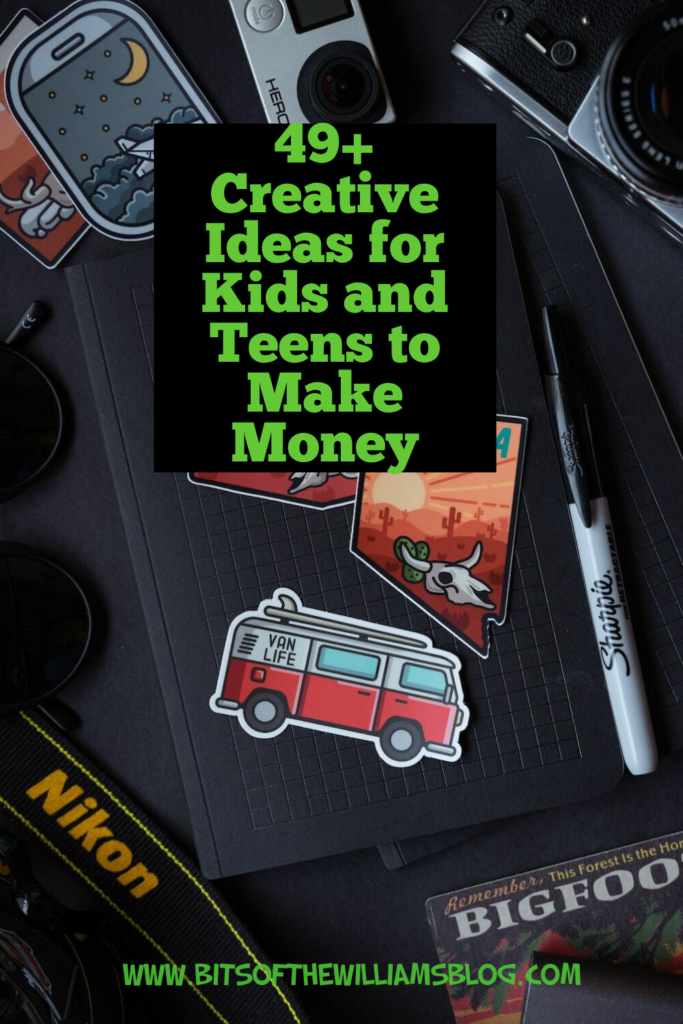

by bitsofthewilliams | Aug 5, 2023 | BACK TO SCHOOL EDITION, PARENTING
With the back-to-school season just around the corner, it’s time to stock up on delicious and nut-free snacks that will keep your kids energized and focused throughout the school day. Many schools have peanut-free policies to ensure the safety of all students, making it important to find alternative snacks that are equally tasty and nutritious. In this blog post, we’ll explore a variety of popular back-to-school snacks that are free of peanut butter and perfect for peanut-free classrooms.
-
Sunflower Seed Butter and Banana Roll-Ups: Swap out peanut butter for sunflower seed butter, a nut-free alternative that’s rich in protein and healthy fats. Spread sunflower seed butter on a whole wheat tortilla, add banana slices, and roll it up for a delicious and satisfying snack.
-
Hummus and Veggie Cups: Pack small containers with hummus and a variety of veggie sticks, such as carrot, celery, and cucumber. These crunchy and colorful bites offer a dose of vitamins and fiber, and kids will love dipping them in creamy hummus.
-
Cheese and Whole Grain Crackers: Create a snack pack with slices of cheese and whole grain crackers. This classic combo is a great source of protein and calcium, supporting your child’s growth and bone health.
-
Yogurt with Berries and Granola: Opt for yogurt cups or pouches that are free of nuts and packed with probiotics. Top with fresh berries and a sprinkle of nut-free granola for a wholesome and satisfying snack.
-
Popcorn with Herbs: Air-popped popcorn is a fantastic whole grain snack. Season it with herbs like rosemary, thyme, or nutritional yeast for a flavorful twist that kids will enjoy.
-
Trail Mix with Seeds: Create a trail mix using a mix of seeds like pumpkin seeds, sunflower seeds, and chia seeds, along with dried fruits and a touch of dark chocolate. This nutrient-rich snack is perfect for a quick energy boost.
-
Rice Cakes with Almond Butter: For schools that allow tree nuts but not peanuts, almond butter is a great alternative. Spread almond butter on rice cakes and add a drizzle of honey for a tasty and filling treat.
-
Fruit Salad Cups: Prepare fruit salad cups with a mix of colorful fruits such as grapes, berries, melon, and kiwi. Pack them in small containers for a refreshing and vitamin-packed snack.
-
Pretzel Sticks with Hummus: Pretzel sticks are a crunchy and fun snack that pairs perfectly with hummus. Choose whole grain pretzels for added fiber and dip them in hummus for a delightful flavor combination.
-
Apple Slices with Seed Butter: Another nut-free alternative is seed butter, such as pumpkin seed or sesame seed butter. Spread it on apple slices for a sweet and savory snack that’s rich in nutrients.
Navigating peanut-free classrooms doesn’t mean compromising on taste or nutrition. These nut-free back-to-school snack ideas offer a variety of options that are not only delicious but also safe for all students. By incorporating these peanut-free alternatives into your child’s daily routine, you can ensure they have the energy and sustenance they need to thrive during their school day. Remember to always check school guidelines and be mindful of other potential allergens to create a safe and enjoyable snacking experience for everyone.
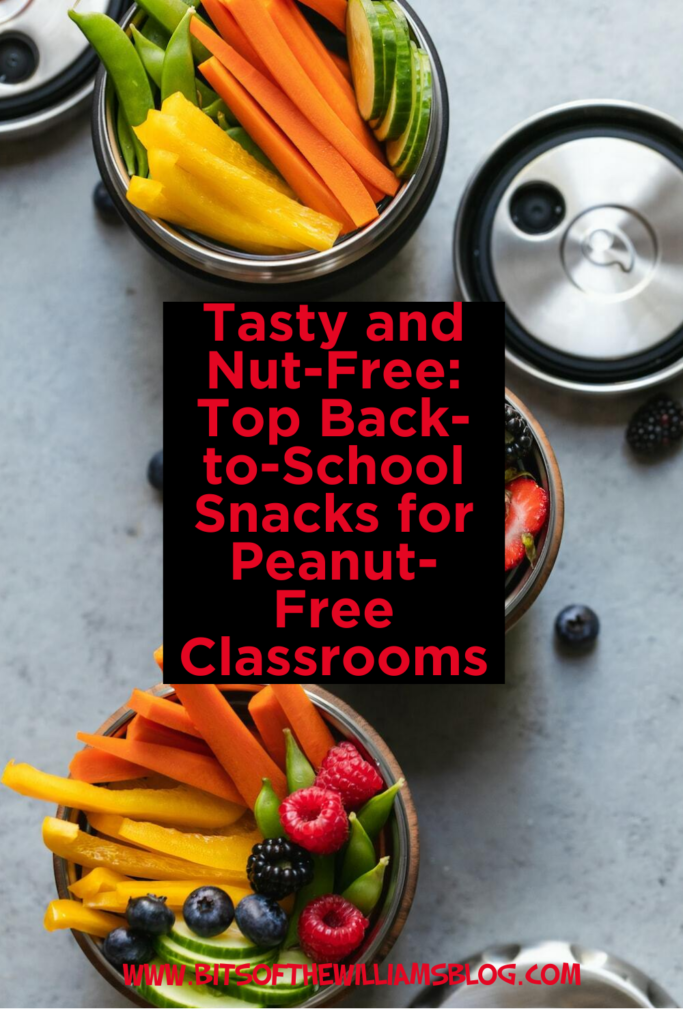
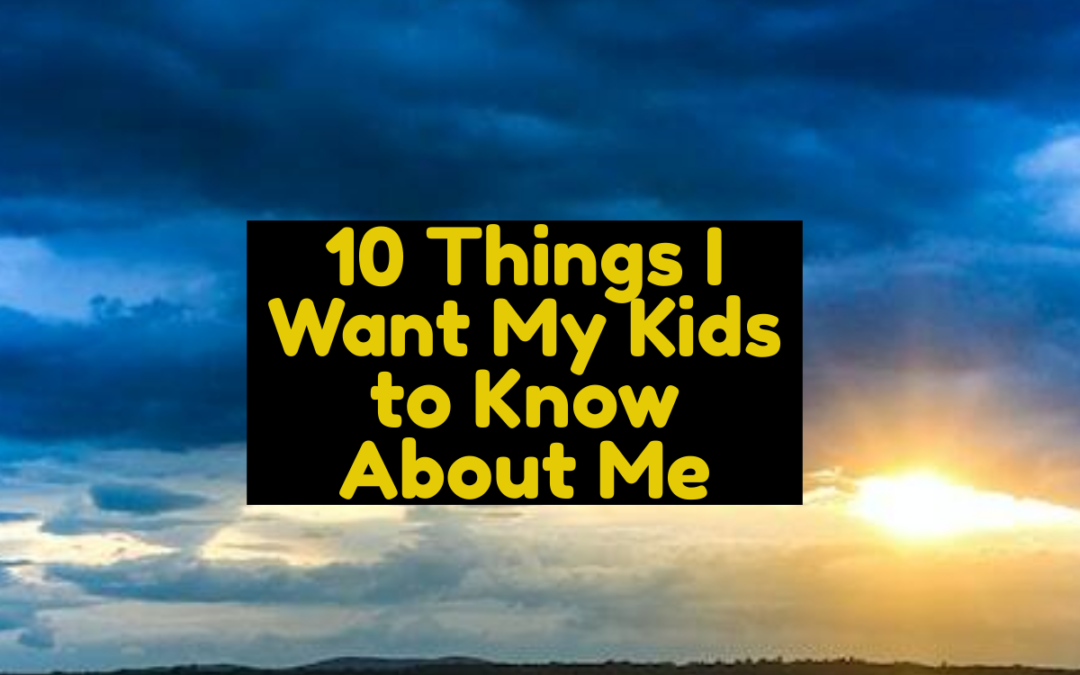
by bitsofthewilliams | Aug 4, 2023 | PARENTING
As a parent, we often focus on teaching and guiding our children, but it’s equally important for them to know and understand us as individuals. Sharing aspects of our lives with our kids helps build a deeper connection and fosters mutual respect. In this blog post, I’ll reveal ten things I want my kids to know about me – the person behind the parent. These insights will not only help them understand me better but also create a stronger bond between us.

-
My Childhood Dreams and Aspirations: I want my kids to know that just like them, I once had dreams and aspirations too. Sharing my childhood ambitions and the journey that led me to where I am today will show them that life is a continuous process of growth and discovery.
-
My Hobbies and Passions: I want my children to know about the hobbies and passions that bring joy to my life. Whether it’s painting, playing a musical instrument, or gardening, these are parts of me that contribute to my happiness and well-being.
-
Life Lessons I’ve Learned: I wish to share the valuable life lessons I’ve learned from my experiences – both successes and failures. My children can benefit from these lessons and perhaps find guidance in their own journey.
-
My Fears and Insecurities: It’s important for my kids to know that I, too, have fears and insecurities. Being vulnerable with them will help create an atmosphere of openness and understanding, where they feel comfortable sharing their own fears and seeking support.
-
How I Met Their Dad: I’d love to share the story of how I met their dad, as it’s a significant part of our family’s history. It will show them the importance of love, commitment, and building strong relationships.
-
The Mistakes I’ve Made: I want my kids to know that I’m not perfect and have made mistakes along the way. Being open about my shortcomings will encourage them to embrace their own imperfections and learn from their missteps.
-
My Dreams and Goals: I’d like to share my current dreams and goals with my children, illustrating that personal growth is a lifelong journey. By sharing my aspirations, I hope to inspire them to pursue their own dreams fearlessly.
-
My Cultural and Family Heritage: My cultural and family heritage is an essential part of who I am. I want my kids to understand their roots, traditions, and values that have been passed down through generations.
-
The Challenges I’ve Overcome: Sharing the challenges I’ve faced and the ways I’ve overcome them will instill in my kids the belief that resilience and determination can help them overcome any obstacles they encounter in life.
-
How Much I Love Them: Above all, I want my children to know just how much I love them. My love is unconditional, and I will always be there to support and cherish them, no matter what.
Opening up and sharing personal aspects of my life with my kids is an essential step in strengthening our bond and fostering mutual respect and understanding. By revealing my dreams, challenges, passions, and experiences, I hope to inspire them, encourage open communication, and create a loving and nurturing environment where they feel comfortable sharing their own thoughts and feelings. Ultimately, I want my children to know that I am not just their parent, but also a person with a unique story, and I cherish the opportunity to share that story with them.

by bitsofthewilliams | Aug 1, 2023 | KIDS CORNER, PARENTING
Bedtime stories hold a special place in the hearts of both parents and children. These magical tales transport little ones to far-off lands, ignite their imagination, and create lasting memories. As parents, we cherish the moments spent cuddled up with our kids, reading stories that evoke a sense of wonder and comfort. In this blog post, we’ll delve into some of our favorite bedtime stories that have become cherished classics, making bedtime a delightful and cherished ritual.

-
“Goodnight Moon” by Margaret Wise Brown: A beloved classic, “Goodnight Moon” is a soothing lullaby that gently bids goodnight to everything in a cozy, moonlit room. With its rhythmic text and calming illustrations, this book has lulled generations of children into peaceful slumber.
-
“Where the Wild Things Are” by Maurice Sendak: This timeless tale follows the adventures of Max, a mischievous boy who sails to a magical land of wild things. This beautifully illustrated story teaches kids about imagination and the importance of returning to the warmth and safety of home.
-
“Guess How Much I Love You” by Sam McBratney: This heartwarming tale of a parent and child’s love is a perfect bedtime story. Little Nutbrown Hare and his parent try to outdo each other in expressing their love, with touching declarations that resonate deeply with both children and parents.
-
“The Very Hungry Caterpillar” by Eric Carle: With its vibrant illustrations and simple storyline, “The Very Hungry Caterpillar” is a delightful bedtime choice. This tale follows a caterpillar’s journey to becoming a beautiful butterfly, teaching kids about growth and transformation.
-
“Love You Forever” by Robert Munsch: This emotionally touching story celebrates the enduring bond between a parent and a child. As the story unfolds, it beautifully captures the lifelong love shared between generations.
-
“Goodnight, Goodnight, Construction Site” by Sherri Duskey Rinker: For little ones who love trucks and construction, this bedtime story is a perfect choice. It follows the busy day of construction vehicles as they wind down to sleep, making it an excellent read for settling down at bedtime.
-
“The Gruffalo” by Julia Donaldson: A tale of wit and adventure, “The Gruffalo” follows a clever mouse’s encounter with various forest creatures. This engaging story keeps kids entertained as they discover how the mouse outsmarts them all.
-
“The Tale of Peter Rabbit” by Beatrix Potter: This classic tale of a mischievous rabbit’s escapades in Mr. McGregor’s garden has enchanted young readers for generations. With its charming illustrations and delightful storyline, it continues to be a bedtime favorite.
Bedtime stories are not just a routine but a cherished tradition that fosters a love for reading and storytelling in children. The enchanting tales of “Goodnight Moon,” “Where the Wild Things Are,” and “Guess How Much I Love You” evoke feelings of warmth and comfort, while “The Very Hungry Caterpillar” and “The Gruffalo” ignite the imagination. “Love You Forever” and “The Tale of Peter Rabbit” impart valuable life lessons. Each of these bedtime stories holds a special place in the hearts of parents and children alike, creating a beautiful bond that transcends generations. As we share these treasured stories with our little ones, we create lasting memories and foster a love for storytelling that will stay with them throughout their lives. So, as the stars twinkle in the sky, let the magic of bedtime stories fill the air and guide our children into sweet slumbers.
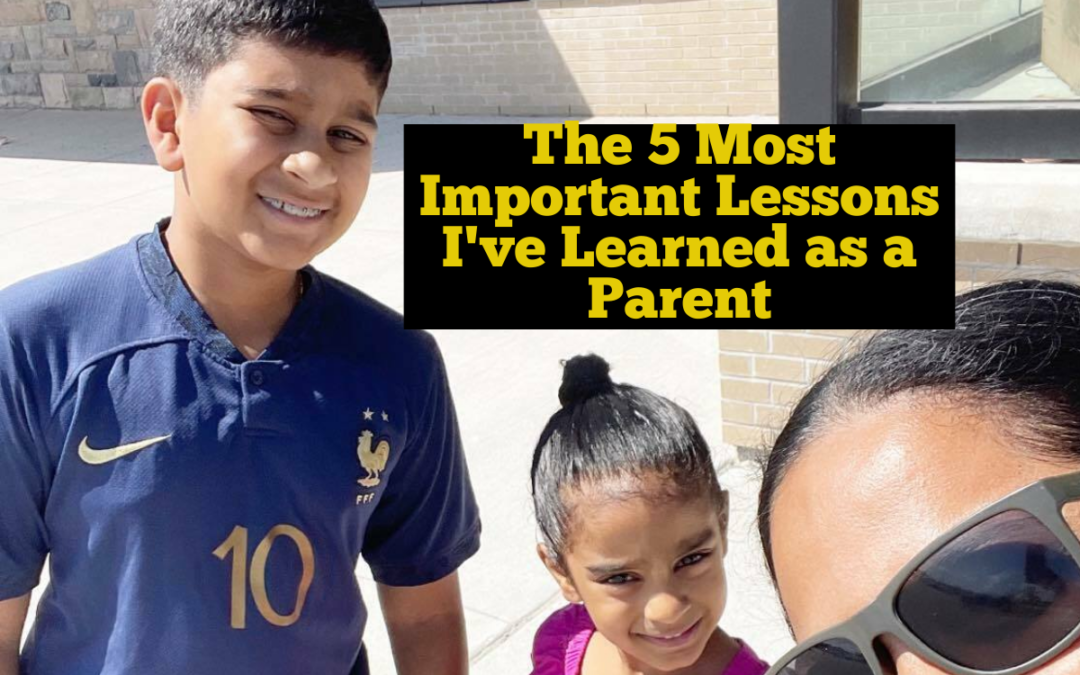
by bitsofthewilliams | Jul 27, 2023 | PARENTING
Parenting is a journey filled with love, joy, challenges, and personal growth. As a parent, we constantly learn and adapt to the needs of our children, discovering valuable insights along the way. In this blog post, I’ll share the five most important lessons I’ve learned on my parenting journey. These lessons have not only shaped me as a parent but have also enriched the bond with my children, making this beautiful journey all the more rewarding.
-
Patience is a Virtue:
The first and perhaps most crucial lesson I’ve learned as a parent is the value of patience. Parenting tests our patience daily, from dealing with tantrums to navigating through adolescence. Learning to take a deep breath, stay calm, and respond with patience and understanding has made a significant difference in my interactions with my children. Embracing patience has allowed me to be more empathetic and supportive, fostering a positive and nurturing environment at home.
-
Embrace Imperfection:
Parenting comes with its share of highs and lows, successes, and mistakes. Learning to embrace imperfection has been a liberating lesson. I’ve realized that I don’t have to be a perfect parent, but rather a loving and present one. Embracing my flaws and being honest about them with my children has shown them that it’s okay to make mistakes and learn from them. This lesson has allowed me to release unnecessary pressure and focus on building meaningful connections with my kids.
-
Be Present in the Moment:
In this fast-paced world, it’s easy to get caught up in distractions and obligations. However, the most valuable gift we can give our children is our presence. I’ve learned to put away screens, be fully engaged, and actively listen when my children speak to me. Being present in the moment has enabled me to truly understand my children’s thoughts, feelings, and needs. It has also enriched our shared experiences, creating lasting memories that we cherish.
-
Allow Space for Independence:
As parents, our instinct is to protect and guide our children at every step. However, I’ve learned that it’s essential to allow space for independence. Allowing them to make age-appropriate decisions, explore their interests, and take calculated risks has empowered my children to develop their own identity and problem-solving skills. Balancing guidance with freedom has nurtured their confidence and sense of responsibility.
-
Lead by Example:
Children learn by observing their parents. I’ve realized that my actions speak louder than my words. As a parent, I strive to lead by example, demonstrating the values and behaviors I want to instill in my children. Whether it’s showing kindness, resilience, or perseverance, being a positive role model has a profound impact on their character development.
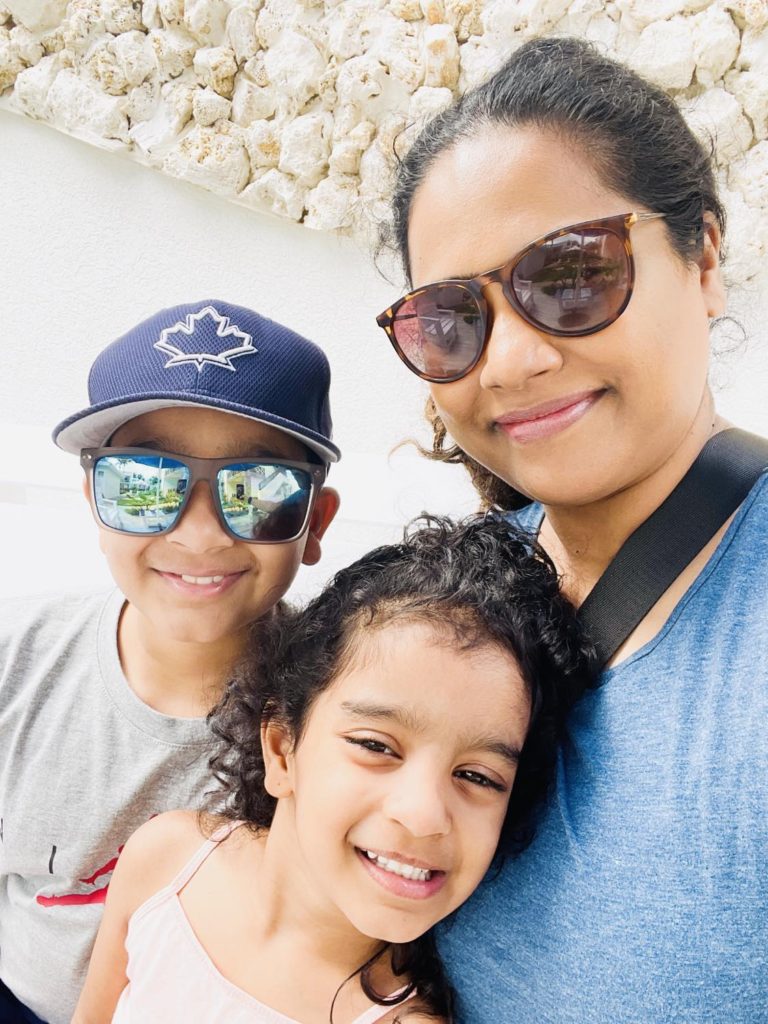
Parenthood is a continuous journey of growth and learning, with valuable lessons to be discovered at every turn. The five lessons I’ve shared have significantly shaped my approach to parenting and strengthened the bond with my children. Embracing patience, imperfection, and being present has enriched our family dynamic, fostering understanding and love. Allowing space for independence and leading by example have empowered my children to grow into confident and compassionate individuals. As a parent, I’m grateful for these essential lessons, knowing that they will continue to guide me in nurturing a loving and supportive environment for my children as they continue to blossom and flourish.














